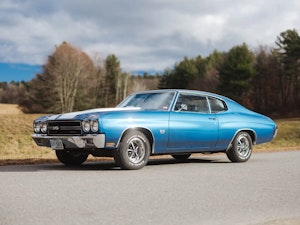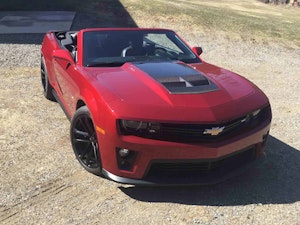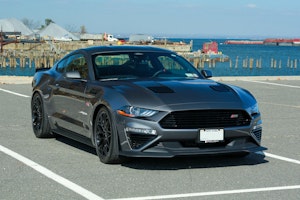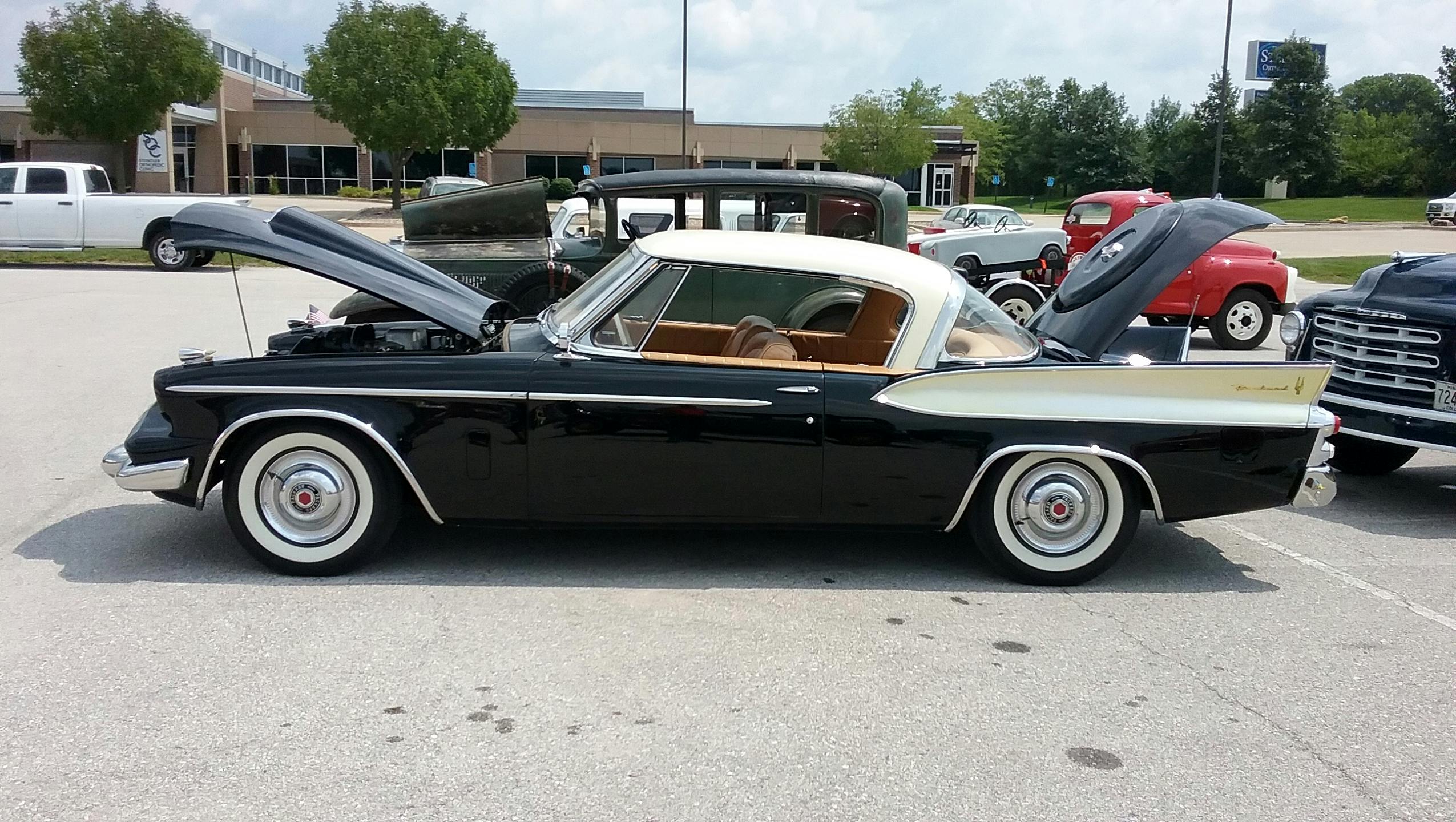Media | Articles
1958 Packard Hawk: All in All, Not a Bad Way to Go
Packard was such a great luxury car. And I’ve always loved Studebakers too, from the Art Deco-style cars of 1932-33 to the bullet nose ’50-’51s and the Gran Turismo Hawks of 1962 to 1964. But long story short, the merger of the two was not good for Packard. However, it did produce some interesting variations. Perhaps the most interesting offshoot of those times—or most odd, if you prefer—is the one-year-only Packard Hawk.
The Hawk was an extension of the all-new 1953 Studebakers, the sleek Commander two-door hardtop in particular. In 1956, a new, taller hood and trapezoid central grille were added among other new trim details, and they became the Hawk series, with the Golden Hawk the top of the line, complete with a Packard V-8 under the hood.
But starting in 1957, Studebaker’s own 289-CID V-8 was found under the hood of new Golden Hawks, and was supercharged to boot. New and oh-so-trendy fins were added as well. With its power and style, it was one of the more compelling—and fast—choices in new cars that year.
Unfortunately, Studebaker-Packard Corporation was in poor health financially during this time. “True” Packards ended in 1956. 1957 Packard Clippers were essentially super-deluxe Studebakers, though they did receive 1955-56 Packard styling cues, including the instrument panel. But beneath the skin, it was mostly the top Studebaker sedan, the President Classic. A nice car in its own right, but not really a Packard.
Originally, this was to be a stop-gap solution, with all new and truly large Packards to appear a year or two after, partially designed by Richard Teague. But the money never came in, and there never was another all-new Packard, strictly speaking.
Marketplace
Buy and sell classics with confidence
That said, there were the 1957 Packard Clippers, available only as a four-door sedan and a four door wagon, dubbed “Country Sedan.” And 1958 brought, surprisingly, additional Packard models.
It was the final year for the company, yet the Packard series, comprised of the Packard 4-door Sedan, Packard Hardtop, and Packard Station Wagon (all without model names) got a heavy, and rather wild, facelift with quad headlamps and unusual double fins on the rear.

Then there was the Hawk. The Packard Hawk was essentially a Studebaker Golden Hawk with a long, low “catfish” style grille, gold Mylar inserts in the fins, leather interior, and a simulated spare tire sunk into the trunk lid, among other minor details.

As an ad declared, “It is designed with that imaginative flair you only expect to find in Europe’s most fashionable automobiles…a regal air that immediately distinguishes its owner as a man of position. Put yourself in that position…behind the wheel of a Packard Hawk, soon.”
While I’m sure few people were fooled, it was all in all a nice car. It still had the swoopy lines of the Golden Hawk, an even more sumptuous interior (borrowed from the extra glitzy and rarely seen Golden Hawk ‘400’), full instrumentation in a handsome engine turned dash, and—best of all—the supercharged 289-CID V-8, with a 3.56-inch x 3.63-inch bore and stroke, and good for 275 horsepower!
The 1958 Packard Hawk had a $3,995 MSRP, weighed in at 3,470 pounds, and only 588 were built. For comparison’s sake, a ’58 Golden Hawk based at $3,282 and sales were slightly better, but still really low, to the tune of 878 units. But then, 1958 was a recession year, and even fat, healthy car companies like GM were losing thousands of sales.

Not too many folks were optimistic about Studebaker-Packard. And indeed, it was last call. Come 1959, Packard was no more, though the corporation continued to be called Studebaker-Packard for several years after the cars’ demise.
And those final cars were not really the majestic luxury cars folks of a certain age at the time had remembered. But the last new car from Packard, this Hawk, was still a pretty cool conveyance. Leather, supercharged V-8, sleek lines, what’s not to like? And a rare birdie, too!
Our featured car was spotted by your author at an SDC Club meet in Iowa City, Iowa, back on August 11, 2018. I was lucky in that I had no idea this show was going on, but my uncle, David Klockau, texted me about it, so I hopped in the Town Car and made the hour jaunt down Interstate 80. I was not disappointed!
In addition to this fine ’58, there was an aquamarine ’58 Golden Hawk, a Wagonaire, a really nice mint green ’53 sedan, and many others. I’d actually been meaning to write this car up for years, but kept forgetting about it. There’s always more shows to attend and cars to gawk at! I’m happy to finally give this final-year Packard model its due.
But wait, there’s even more! While I was working on this column, I ran across pictures of another ’58 Hawk I saw when I visited the Studebaker National Museum (if you find yourself in South Bend, I highly recommend it) back in 2015 with my friend Jim Cavanaugh, an Indianapolis resident and fellow Studebaker nut.
It was fetching in its gunmetal gray paint with saddle tan leather, and I recall gawking at it for some time. At least until I caught the last Studebaker built, a turquoise metallic ’66 Cruiser, out of the corner of my eye, and went scampering away to it! So expect more Studebakers sometime soon.
One final note. In preparing this column, I used some brochures I received from Suzanne Reid. Her dad was another Studebaker fan and owned several. She had a number of booklets and brochures from the ’50s and ’60s and was kind enough to send them to me when they needed a good home.
I was thrilled to receive them and spent quite some time reading through them. They were a great help in pinning down some of the details for this column. I thank you, ma’am!
***
Check out the Hagerty Media homepage so you don’t miss a single story, or better yet, bookmark it. To get our best stories delivered right to your inbox, subscribe to our newsletters.















































While in South Bend do not miss the opportunity to drive around the ND campus. In summer with the students gone it is landscaped to the tens. Absolutely grand, as compared to South Bend itself which is a dump…
Gorgeous interior but still have trouble liking that nose.
Amen,great car
Yeah, looks like a big catfish; but you have to admit: pretty aerodynamic for the day.
That nose tried to mimic the current European GP cars of the mid-fifties, and as a stand-alone feature, it isn’t bad. Just didn’t fit what was left of the Starlite Stude body. Besides the quilted Mylar and nutty fins, it isn’t at all a bad design, really. They look better ‘in person’ than in photos, renderings.
Is that ‘classic’ Packard coupe a 120 model? Had one; Packard clubs never wanted to consider it worthy, but they were neat cars and much more modern than the true Classic (fire-truck) Packards! Purdy! Wick
Wick, you’re right as rain about the One Twenty. It or its Clipper variant garnered Consumer Reports’ Best Buy rating every year 1938-47. The senior fire trucks copied the 1935 120’s i.f.s. and hydraulic brakes from 1937-on, and all Packard’s 1939 on other than 446 leftover Twelves were junior based.
All Cadillacs 1936-on were downsized and shared components with lesser GMobiles. Most Lincolns 1936-on were “Ford and a half” Zephyrs. The 1936 Cord was originally called “the baby Duesenberg” by A-C-D employees.
Times have changed, Wick, but decades ago the Packard and other clubs were full of pompous old coupon clippers who sneered at anything but their comic opera ’30s senior models. If you want to split hairs, Pierce had the best engines of all the ’30s heavy iron, and that includes the overrated, over-hyped, over-priced Duesenberg, obsolete two years after its introduction, taking eight years and several iterations to find homes for a mere 480 of them. Both the Pierce 8 and V-12 went into Seagraves fire trucks, just as the Auburn/Lycoming V-12 wound up in American LaFrance fire trucks, so that term is more accurate than you might realize.
On the other hand, Hagerty, appealing to the masses, terms anything out of the Kelley Blue Book a “classic.”
So we have to think for ourselves, Wick. But now and then, something of interest on Hagerty, so here we are.
Learned to drive in my high school buddies older brothers ’58 Hawk. It was that funny pink/orangeish color but I always remember what a solid car it felt like. Styled to the nines for the time! I’d say it was 1 of the early “personal luxury” cars
Nice car but not a real Packard.
This same iss has hurt Cadillac and Lincoln where they had models that were more Chevy vs Cadillac and mor Ford than Lincoln.
I may be wrong, but from what I remembered reading Studebaker was the worse-off one of the two when that merger occurred. True, Packard was in bad shape as well, having lost its status as a luxury marque and struggling for its identity; but it wasn’t quite so bad off financially as Studebaker, until after the merger. Mergers among the independent marques were popular in that decade, as a desperate attempt to pool their resources to hold their own against the Big Three, which as we know didn’t work out for anyone involved. There is no doubt that Studebaker sucked all of Packard’s assets dry, and the gussied-up Studebakers with Packard badges didn’t fool anyone. And THEN, the flash-recession of 1958 just dealt the final fatal blow.
Few mergers are with two healthy companies.
Right. A merger of a healthy company and one less fortunate is usually called a hostile takeover.
Absolutely, Anthony. Thomas Klockau gets the story straight, while his friend Jason Coombes’ nice ’35 Packard coupe provides historic perspective. After the war, all independents were doomed, unable to approach Big Three leveraged component purchasing power, tool amortization, unit costs, afford expensive TV advertising and increasingly “necessary” annual styling revisions. Postwar Rolls-Royce/Bentley were cagily advertised downmarket assembled boutique products using GM components, and nut for bolt copy of Packard’s prewar “Safe-T-Flex” i.f.s. (which postwar Lagonda used at the rear), bodies stamped by Pressed Steel of Cowley near Oxford, who furnished much of England’s auto industry. Hispano-Suiza survives making nuclear power plant pumps.
Great synopsis of what was the final Packard. These are actually sleeper classics and the remaining coveted for rareness and quirky styling if not the powerful and tech advanced underpinnings!
Ask the man who owns one…
This article was a Treasure Chest of Packard information. It was Very Unfortunate that Packard did not get the Opportunity to come out with the NEW Models in 1960 .
I’m restoring a 57 Packard Town & County wagon. Total of 869 production, and the first wagon ever with a supercharger.
No one ever guesses the correct brand of the car. Rumors are there’re about 300 left. Many people said “Street rod it”, but keeping it original. Other standard fratures;
Power steering, brakes, posi rear, and the same Wonder Bar radio as a 56 Chevy.
Should be on the road by next year.
It’s a 2 tone turquoise & white.
Would love to see some pics of the project..
These are the real ‘last Packards’ and surely some of the most rare. Amazing that Stude could turn the basic 1953 sedan body into this… AND the ’59 Lark! (Or Avanti?) Perhaps Chevy should have stuck with the ’55 frame and body basics?
The Avanti, Wick, was on the short Lark chassis. The Hawk was a better car, longer wb, so better directional stability. Al Kolbe, who worked on the 1932-39 Packard Twelve, was chief project engineer on the ’55 Chevy V-8. Other than the President of the early ’30s, Studes were essentially Chevy quality. Not bad, just so so.
The last “real” Packards were the ’56s built in Detroit. The 1957-58s were only rebadged Studes. Packard was floundering from the 1948 bathtubs on, as were all independents, unable to approach Big Three leveraged component purchasing power, unit cost, tool amortization, afford silly annual cosmetic redesigns, TV advertising. R-R/Bentley focused on aero engines 1935-on, the postwar cars rationalized downmarket assembled product using GM components, their i.f.s. a nut or bolt copy of Packard’s prewar i.f.s., bodies stamped out by Pressed Steel of Cowley near Oxford, who supplied much of the English auto industry, just as Briggs and Murray did in Detroit.
when people tell me i should rod my 47 Plymouth coupe, they get a very vulgar reply. i,m too old to put up with idiots
Good for you, HD. Only characters too ignorant to appreciate or know anything about older cars are the ones trashing them to make retro rod Frankencars.
George Mason died October 8th , 1954. I was born October 8th, 1954. I sometimes wonder if that’s the reason I like both Studebakers and Packards.
I was born and spent my first decade in Warren Ohio, birthplace of Packard. Last time I visited, the old municipal swimming pool building had been turned into a Packard museum with (mostly) early cars on display. This would be an awesome bookend!
Great looking car from the golden age of American automobiles. Thanks for the memories.
Not the prettiest face but it otherwise looks fine on the outside. The interior is gorgeous. 275hp sounds very good for the day.
Packard Hawks are just soooooo ugly compared to the beautiful Studebaker Hawks. Have you ever seen another car with it’s interior upholstery extended to the exterior of the car?
Upholstery: several European prestige cars did it first. Not a great idea for cars that might sit out in weather!
Note the 1955-6 Mercurys that had a similar effect, but without the padding and viny. Novel, if no better.
There’s one on display at the Gilmore in Hickory Corners too. I was speaking with a diehard Studebaker fan at Hagerty’s Cars and Caffeine who told me that Studebaker stopped building cars because they were making more money with their other businesses than they were with the car business.
Studebaker Corporation was one of the first conglomerates. If I remember correctly, it had sixteen divisions, fifteen of which were profitable. Only the automobile manufacturing division lost money…more than the other fifteen combined. Don’t hold me to the actual numbers, but one of Studebaker’s annual reports opened with the statement “Last year fifteen of our operating divisions had combined income of $1 million. Unfortunately, our automotive division had a loss of $4 million so your company has to report a loss of $3 million for the fiscal year.” The ending of automobile production made financial sense.
As it turned out, they were “ahead of their time” in that, too.
Years ago, there was a Packard Hawk for sale locally. I knew they were rare, and considered buying it, but bought a 5 year old Marlin instead. They wanted $750 for the Packard, which I thought was too much at the time. It was rare, but nobody cared back then- including the Packard snobs.
Turn the clock forward 30 years; there was a disassembled Packard Hawk behind an industrial complex nearby. Evidently a stalled restoration. Never asked about it.
It disappeared at one point, fate unknown.
I own one of the last true Packards, a ’56 Executive. Only 1036 of the 2 door model were built before Packard ceased production in June ’56. Interesting car, had an electric push button transmission, a torsion bar suspension with no coil or leaf springs, and an electric self leveling system that entertains my friends. The ’57 and ’58 models were nicknamed Packardbakers.